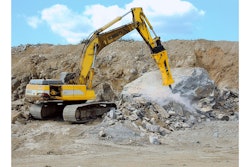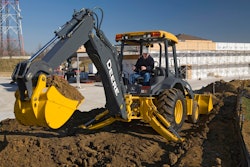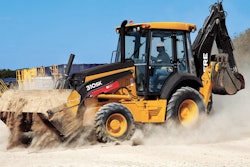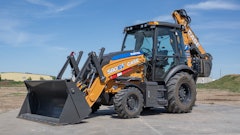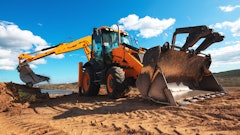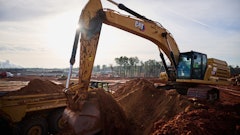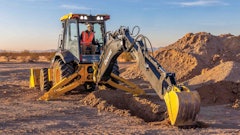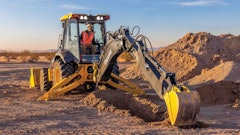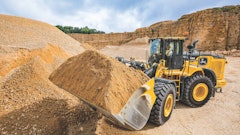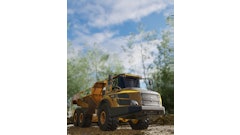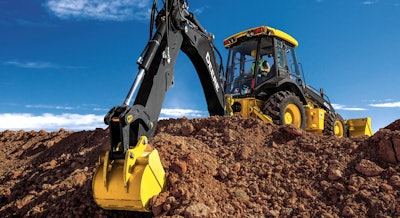
In the most basic sense, a backhoe-loader is designed to do one primary task: Dig. And it does that, very well in fact. Combine that with material lifting and moving capabilities, then team it up with different attachments for added capabilities, and you have a solid machine that can perform numerous tasks on the jobsite.
While all the opportunity for productivity is great, getting the most productivity out of a backhoe is not about buying more attachments, filling up the bucket or driving the machine faster around the jobsite. There are a few key yet simple operational tips that every operator can use to get more uptime, better results and even increased safety with backhoe operation.
Thorough Training
Whether a 10-year veteran of a company or a new employee, the first step of proper backhoe operation is proper training. And this isn’t limited to operators only; for best results, owners, technicians and anyone else who may work with the machine should be trained on it, as well. A company looking for training assistance can start with the dealership. RDO Equipment Co. and other reputable dealers typically provide free training at the time of equipment setup.
Equipment professionals looking to go the extra mile can take the initiative to do individual training too. Reading the operator’s manual, learning the controls, even watching videos from the manufacturer can all help operators hone their skills.
Pre-operation Operation
Even after basic training is complete, every operator must be fully comfortable with how a particular machine operates before beginning any work. With numerous settings and options, each machine will be different, and those differences can range from barely noticeable to something that would drastically affect operation.
Take time to get familiar with controls. Most backhoes are set up to run on either a backhoe or excavator digging control pattern so every operator should check the setting to be aware of the option, and, if needed, adjust to suit preference. Also important is to get a feel for the unit’s steering. Depending on the model of backhoe, steering can be touchy, similar to a car.
Regular Routine Maintenance
At the start of every work day, the machine operator should conduct basic maintenance checks to ensure the backhoe is primed and ready to go. For added convenience, some manufacturers, like John Deere, include a maintenance chart right on the machine. An example of a basic, daily checklist might look something like this:
- Check for anything that appears to be damaged or could interfere with operation
- Check for flat tires or signs of inadequate inflation
- Check all fluids (fuel, oil, hydraulic fluid, DEF, and coolant/anti-freeze)
- Check high-activity areas of the machine and apply grease where needed
- Check wear parts; replace as needed
Standard Safety Checks
Safety is a top priority on most jobsites. Not only does this ensure a proper work environment for employees, it’s key to productive equipment operation, making a pre-operation safety check one of the most important steps of backhoe operation.
Whenever digging is part of a scope of work, a site should be pre-inspected. Any underground obstructions must be properly noted or marked, and communicated to all team members. If this hasn’t been done, a responsible backhoe operator must call before digging to avoid unexpected interruption to work – or worse, damage to underground utility lines and potential safety hazards. In addition to underground utility lines, backhoe operators must be aware of overhead lines as well, and take caution to avoid coming in contact with them.
Additional safe operation tips include:
- Honk the horn prior to moving the machine to alert those nearby
- Ensure the boom is locked and swing lock is in place before driving the machine
- Never leave the operator seat when the backhoe is running
- Do not go under the machine if it’s running
When it’s time to shut off the machine, park it on a stable surface, then lower both the loader and bucket so they’re resting securely on the ground, and engage the parking brake.
Warm Up to Cool Down and Everything in Between
The above areas discussed are all important to achieving optimum backhoe operation. But what about actual operating tips? Here are six best practices every operator can adopt.
- After starting the machine, allow it to warm up a bit before engaging the controls. This gives hydraulic fluid the chance to circulate and warm up, preventing potential hiccups to operation.
- When positioning the machine to dig, engage the stabilizers to prevent the machine from rocking or tipping. For best control, expand the stabilizers to their full width.
- Don’t overload the bucket. It may seem like a way to enhance productivity and efficiency but an overloaded bucket can spill material and strain the loader – causing both immediate and long-term stalls to operation.
- Keep the bucket low during transport. This will help prevent material spillage and also protect the machine from tipping in the event an obstacle or hole is encountered.
- Avoid having to go back and re-dig areas by dumping away from the immediate excavation area.
- At the end of the day, allow the machine ample time to cool down before fully shutting it off. Maintenance checks, especially to the engine, should only be done when the machine has cooled completely.
Although it’s by no means rocket science, optimum backhoe performance doesn’t happen by accident. Equipment professionals must apply a thoughtful and thorough approach to operation, every day, in order to get the most out of a backhoe.



